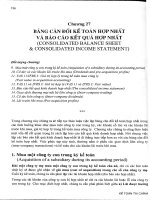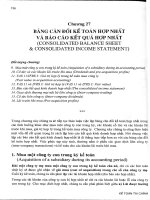Gíao trình kế toán bằng tiếng anh ch14
Bạn đang xem bản rút gọn của tài liệu. Xem và tải ngay bản đầy đủ của tài liệu tại đây (4.1 MB, 60 trang )
Chapter 14
Financial Statement
Analysis
Learning Objectives
After studying this chapter, you should be able to:
1. Discuss the need for comparative analysis.
2. Identify the tools of financial statement analysis.
3. Explain and apply horizontal analysis.
4. Describe and apply vertical analysis.
5. Identify and compute ratios used in analyzing a firm’s liquidity, profitability, and
solvency.
6. Understand the concept of earning power, and how irregular items are presented.
7. Understand the concept of quality of earnings.
14-1
Preview of Chapter 14
Managerial Accounting
Sixth Edition
Weygandt Kimmel Kieso
14-2
Basics of Financial Statement Analysis
Analyzing financial statements involves:
Comparison
Bases
Characteristics
Liquidity
Intracompany
Horizontal
Profitability
Vertical
Solvency
Industry
averages
Ratio
14-3
Tools of
Analysis
LO 1
LO 2
Intercompany
Discuss the need for comparative analysis.
Identify the tools of financial statement analysis.
Horizontal Analysis
Horizontal analysis, also called trend analysis:
14-4
Technique for evaluating a series of financial statement
data over a period of time.
Purpose is to determine the increase or decrease that has
taken place.
Commonly applied to the balance sheet, income statement,
and statement of retained earnings.
LO 3 Explain and apply horizontal analysis.
Horizontal Analysis
Balance Sheet
These changes
suggest that the
company expanded its
asset base during
2009 and financed
this expansion
primarily by retaining
income rather than
assuming additional
long-term debt.
Illustration 14-5
Horizontal analysis of
balance sheets
14-5
LO 3
Horizontal Analysis
Income
Statement
Overall, gross profit
and net income were
up substantially. Gross
profit increased
17.1%, and net
income, 26.5%.
Quality’s profit trend
appears favorable.
Illustration 14-6
Horizontal analysis of
Income statements
14-6
LO 3 Explain and apply horizontal analysis.
Horizontal Analysis
Retained Earnings Statement
Illustration 14-7
Horizontal analysis of
retained earnings statements
Ending retained earnings increased 38.6%. As indicated earlier, the company
retained a significant portion of net income to finance additional plant
facilities.
14-7
LO 3
Financial information for Rosepatch Company is as follows.
Compute the amount and percentage changes in 2014 using
horizontal analysis, assuming 2013 is the base year.
14-8
LO 3
Vertical Analysis
Vertical analysis, also called common-size analysis:
14-9
Technique that expresses each financial statement item as
a percent of a base amount.
On an income statement, we might say that selling
expenses are 16% of net sales.
Commonly applied to the balance sheet and the income
statement.
LO 4 Describe and apply vertical analysis.
Vertical Analysis
Balance
Sheet
These results
reinforce the earlier
observations that
Quality is choosing
to finance its
growth through
retention of
earnings rather
than through
issuing additional
debt.
Illustration 14-8
14-10
LO 4
Vertical Analysis
Income
Statement
Quality appears
to be a profitable
enterprise that is
becoming even
more successful.
Illustration 14-9
14-11
LO 4
Vertical Analysis
Enables a comparison of companies of different sizes.
Illustration 14-10
14-12
LO 4
Ratio Analysis
Ratio analysis expresses the relationship among selected
items of financial statement data.
Financial Ratio Classifications
14-13
Liquidity
Profitability
Solvency
Measures shortterm ability of the
company to pay its
maturing obligations
and to meet
unexpected needs
for cash.
Measures the
income or operating
success of a
company for a given
period of time.
Measures the ability
of the company to
survive over a long
period of time.
LO 5 Identify and compute ratios used in analyzing a
firm’s liquidity, profitability, and solvency.
Ratio Analysis
A single ratio by itself is not very meaningful.
Ratios will include the following types of comparisons.
1. Intracompany comparisons for two years for Quality
Department Store.
2. Industry average comparisons based on median ratios for
department stores.
3. Intercompany comparisons based on J.C. Penney Company
as Quality Department Store’s principal competitor.
14-14
LO 5 Identify and compute ratios used in analyzing a
firm’s liquidity, profitability, and solvency.
Ratio Analysis
Liquidity Ratios
Measure the short-term ability of the company to pay its
maturing obligations and to meet unexpected needs for cash.
14-15
Short-term creditors such as bankers and suppliers are
particularly interested in assessing liquidity.
Ratios include the current ratio, the acid-test ratio,
receivables turnover, and inventory turnover.
LO 5 Identify and compute ratios used in analyzing a
firm’s liquidity, profitability, and solvency.
Ratio Analysis
1. Current Ratio
Liquidity Ratios
Illustration 14-12
The ratio of 2.96:1 means that for every dollar of current liabilities,
Quality has $2.96 of current assets.
14-16
LO 5
Ratio Analysis
2. Acid-Test Ratio
14-17
Liquidity Ratios
Illustration 14-13
LO 5
Ratio Analysis
Liquidity Ratios
2. Acid-Test Ratio
Illustration 14-14
Measures immediate short-term liquidity.
14-18
LO 5 Identify and compute ratios used in analyzing a
firm’s liquidity, profitability, and solvency.
14-19
Ratio Analysis
3. Receivables Turnover
Liquidity Ratios
Illustration 14-15
Number of times, on average, the company collects receivables.
14-20
LO 5
Ratio Analysis
Liquidity Ratios
$2,097,000
Receivables Turnover
= 10.2 times
($180,000 + $230,000) ÷ 2
A variant of the receivables turnover ratio is to convert it to an
average collection period in terms of days.
365 days ÷ 10.2 times = every 35.78 days
This means that receivables are collected on average every 36
days.
14-21
LO 5 Identify and compute ratios used in analyzing a
firm’s liquidity, profitability, and solvency.
Ratio Analysis
Liquidity Ratios
4. Inventory Turnover
Illustration 14-16
Number of times, on average, the inventory is sold.
14-22
LO 5
Ratio Analysis
Liquidity Ratios
$1,281,000
Inventory Turnover
= 2.3 times
($500,000 + $620,000) ÷ 2
A variant of inventory turnover is the days in inventory.
365 days ÷ 2.3 times = every 159 days
Inventory turnover ratios vary considerably among industries.
14-23
LO 5 Identify and compute ratios used in analyzing a
firm’s liquidity, profitability, and solvency.
Ratio Analysis
Profitability Ratios
Measure the income or operating success of a company for a
given period of time.
14-24
Income, or the lack of it, affects the company’s ability to obtain
debt and equity financing, liquidity position, and the ability to
grow.
Ratios include the profit margin, asset turnover, return on
assets, return on common stockholders’ equity, earnings
per share, price-earnings, and payout ratio.
LO 5 Identify and compute ratios used in analyzing a
firm’s liquidity, profitability, and solvency.
Ratio Analysis
Profitability Ratios
5. Profit Margin
Illustration 14-17
Measures net income generated by each dollar of sales.
14-25
LO 5









